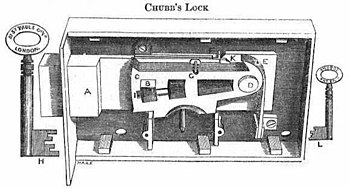
Locksmithing is the science and art of making and defeating locks. Locksmithing is a traditional trade and in many countries requires completion of an apprenticeship. The level of formal education legally required varies from country to country from none at all, to a simple training certificate awarded by an employer, to a full diploma from an engineering college, in addition to time spent working as an apprentice.

Lock picking is the practice of unlocking a lock by manipulating the components of the lock device without the original key.
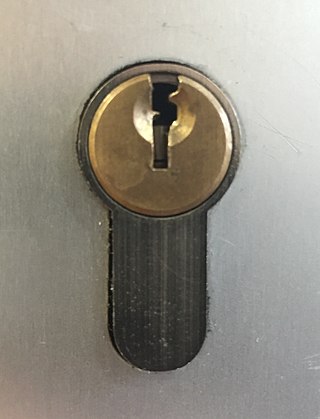
The pin tumbler lock, also known as the Yale lock after the inventor of the modern version, is a lock mechanism that uses pins of varying lengths to prevent the lock from opening without the correct key.

A lock is a mechanical or electronic fastening device that is released by a physical object, by supplying secret information, by a combination thereof, or it may only be able to be opened from one side, such as a door chain.

A lever tumbler lock is a type of lock that uses a set of levers to prevent the bolt from moving in the lock. In the simplest form of these, lifting the tumbler above a certain height will allow the bolt to slide past.
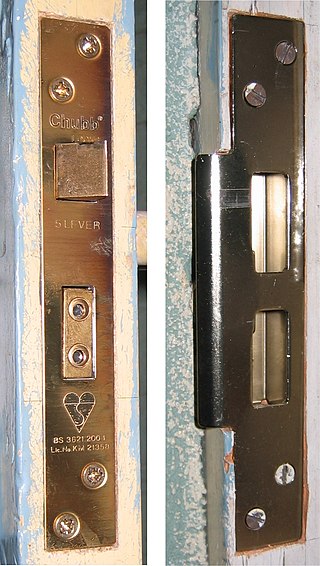
A mortise lock is a lock that requires a pocket—the mortise—to be cut into the edge of the door or piece of furniture into which the lock is to be fitted. In most parts of the world, mortise locks are found on older buildings constructed before the advent of bored cylindrical locks, but they have recently become more common in commercial and upmarket residential construction in the United States. The design is widely used in domestic properties of all vintages in Europe.

Joseph Bramah was an English inventor and locksmith. He is best known for having improved the flush toilet and inventing the hydraulic press. Along with William Armstrong, 1st Baron Armstrong, he can be considered one of the two fathers of hydraulic engineering.

A rotary combination lock is a lock commonly used to secure safes and as an unkeyed padlock mechanism. This type of locking mechanism consists of a single dial which must be rotated left and right in a certain combination in order to open the lock.

"The Adventure of the Golden Pince-Nez", one of the 56 Sherlock Holmes short stories written by Sir Arthur Conan Doyle, is one of 13 stories in the cycle collected as The Return of Sherlock Holmes (1905). It was first published in The Strand Magazine in the United Kingdom in July 1904, and was also published in Collier's in the United States in October 1904.

Alfred Charles Hobbs was an American locksmith and inventor. He was born in Boston, Massachusetts, in 1812; his father was a carpenter. He married Charlotte F. Nye (1815-?) of Sandwich, Massachusetts, in 1835 and had four children: Charlotte Hobbs, Alfred J. Hobbs (1843-?), Mary H. Hobbs, and Arthur Hobbs. Both of his parents were born in England.
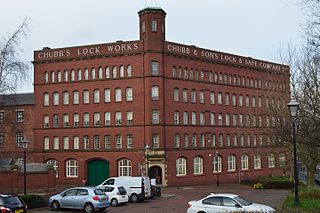
Chubb Locks is a former brand name of the Mul-T-Lock subsidiary of the Assa Abloy Group, which manufactures locking systems for residential, secure confinement and commercial applications. When the brand licence expired in 2010 the name ceased to be used, with the same locks sold as Yale or Union locks.
Ardeshir Burjorji Sorabji Godrej (1868–1936) was an Indian businessman. With his brother Pirojsha Burjorji, he co-founded the Godrej Brothers Company, the precursor of the modern Godrej Group.
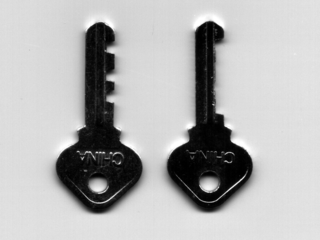
A skeleton key is a type of master key in which the serrated edge has been removed in such a way that it can open numerous locks, most commonly the warded lock. The term derives from the fact that the key has been reduced to its essential parts.

A snap gun, also known as lock pick gun, pick gun, or electric lock pick, is a tool that can be used to open a mechanical pin tumbler lock without using the key. A thin steel blade, similar in shape to a lock pick, is inserted into the lock and the snap gun briefly fires the blade against all of the lock pins simultaneously, momentarily freeing the cylinder and enabling it to be turned using a tension wrench. The snap gun is an alternative to a conventional lockpick, which requires other techniques such as raking to free the pins.
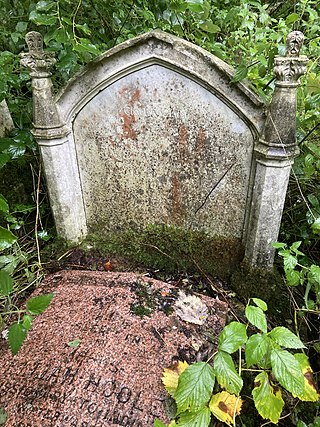
Charles Chubb was an English lock and safe manufacturer.
The term protector lock has referred to two unrelated lock designs, one invented in the 1850s by Alfred Hobbs, the other in 1874 by Theodor Kromer.

A magnetic keyed lock or magnetic-coded lock is a locking mechanism whereby the key utilizes magnets as part of the locking and unlocking mechanism. Magnetic-coded locks encompass knob locks, cylinder locks, lever locks, and deadbolt locks as well as applications in other security devices.
Chubb is a surname. Notable people with the surname include:
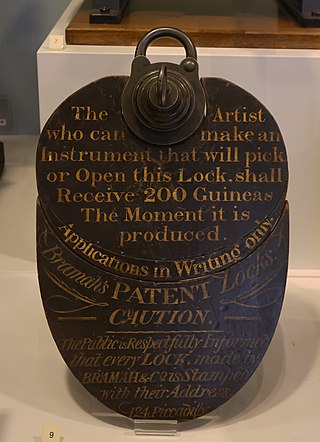
The Bramah lock was created by Joseph Bramah in 1784. The lock employed the first known high-security design.
This is a glossary of locksmithing terms.
